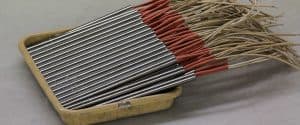How to improve the life of your cartridge heaters
You’ll never find cartridge heaters as reliable as Rama Corporation’s heaters. For decades, various manufacturers have trusted us to supply cartridge heaters for use in many demanding applications. And for decades, the performance of our elements has impressed our customers.
But no matter how high-quality your cartridge heater is, you still have a responsibility to maintain it. That way, it will serve you for as long as you would like it to. So if you’re wondering how to go about doing that, this guide is for you.
Factors to consider
You need to consider several critical criteria to get the best performance and longest life from your cartridge heaters. These include;
1. Operating temperature
Your heater’s operating temperature is crucial to determining its life expectancy. But in this case, it is not so much about the process operating temperatures. Rather, The voltage of the resistance wire inside the heater determines this.
2. Heater watt density
Watt density refers to how much power is used to heat the heated sheath per square inch. The watt density of a heater affects the temperature of the internal resistance wire, which affects the temperature of the outside sheath for a given application.
When thermal dissipation requirements are not met, high watt densities can contribute to premature failure because the core temperature of the heater will surpass the resistive heating element’s limits.
3. Amount of cycling
If the cartridge heater has a higher wattage than required, it will turn on and off often (e.g., 30-60 seconds) to maintain the proper temperature. Excessive temperature cycling is the term commonly used to describe this. It oxidizes the resistance wires quickly, resulting in heater failure.
Therefore, it is worthwhile to research your heater to avoid excessive cycling. To match the needs of your application, you should always determine the least potential wattage before purchasing a heater.
4. Proper Fit
When employing cartridge heaters to warm a platen, die, mold, or hot runner probe, the fitting is essential in deciding how long the heater will last.
The fit is the area between the cartridge heater’s min and max diameters and the hole. Due to swaging, the diameter of unheated parts of a cartridge heater may be reduced.
Only use the correct diameter to determine fit. The ideal hole diameter is no more than 0.002 larger than the heater’s nominal diameter to provide adequate thermal dissipation.
5. Controlling the power
The life expectancy of heaters is affected by power control strategies. On-off controls, while cost-effective, increase the rate of thermal stress and oxidation on heater components by creating large temperature variations in the internal heat source.
Silicon-controlled rectifiers, solid-state power regulators, and mercury relays can improve the lifespan of the cartridge heater by decreasing temperature fluctuations.
6. Temperature Control and Temperature Sensing Device Location
 The use of appropriate temperature regulation and the position of the heater to the sensor are vitally critical for correctly controlling the heater temperature and, thereby, the resistance wire temperature.
The use of appropriate temperature regulation and the position of the heater to the sensor are vitally critical for correctly controlling the heater temperature and, thereby, the resistance wire temperature.
Heaters with a greater watt density can generate heat faster than it can be dissipated by the environment. As a result, there is a temperature lag between the heater and the sensor. The better the temperature control, the nearer the sensor is to the heater.
Placing the sensor far away from the heater in many applications allows it to detect temperature fluctuations of many degrees, particularly in early setup and intensive heat transfer.
The heater may be functioning at a very high temperature, even when the specified operating temperature is moderate. A common reason for heater failure is this. The temperature controllers’ time proportionality and PID functions can help to reduce this.
Final take
The main advantage of a cartridge heater is the ability to reach and transport heat wherever it is needed without wasting much energy in the process. In addition, the protective metallic covering prevents oxidation, and direct contact is the most efficient heat transmission mechanism.
Lower power expenditures result from less energy loss and improved heating process efficacy, making a significant difference given the magnitude of industrial processes.
Temperature sensing capabilities placed into the heater can help control temperatures and prevent overheating, extending its utility and durability. The key to obtaining maximum benefits is to choose the correct product (size and length) for the application.
